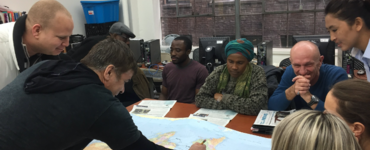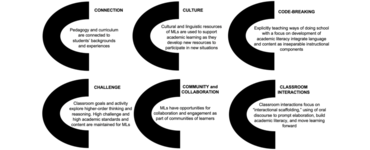“Teaching Adult Immigrants with Limited Formal Education: Theory, Research and Practice,” by Joy Kreeft Peyton and Martha Young-Scholten (Eds). 2020. 191 pages, paperback, $34.95 USD. Multilingual Matters.
Key words: English as a second language, teacher education, LESLLA, SLIFE, refugee education
If you are as hungry as I am for the knowledge and skills to facilitate your journey in becoming the most effective educator you can be to migrants whose literacy proficiency is low, read this book. For the novice, this volume will serve as a graduate course in the current issues, challenges, and research pertaining to teaching immigrants with literacy needs. You are likely to mark, mangle, and annotate every page. If you are already an experienced professional, read this for the joy of discovering the newest research and practical implications related to teaching immigrants with limited education in a ridiculously concise volume. For every educator, practitioner, and researcher seeking a compilation of the latest theory and research on teaching adult migrants to read, this edited volume presents international perspectives from world-renowned practitioners and researchers.
Larry Condelli contextualizes the book in his foreword, as the culmination of decades of research and practice from an international community that coalesced in 2005 and created what is today the Literacy Education and Second Language Learning for Adults organization (LESLLA). Today, LESLLA is unique as the only association devoted solely to the study of second language (L2) acquisition research and teaching as they relate to adult migrants. LESLLA has inspired a European team of researchers to create the Digital Literacy Instructor, or DigLin, a computer program used for testing and learning for adults with low literacy proficiency. LESLLA was also a catalyst for the creation of the European Speakers of Other Languages: Teaching Adult Migrants and Training their Teachers (EU-Speak), a research community that assessed the needs of teachers and delivered training modules to meet them. Out of this laudable history, comes this volume edited by Joy Kreeft Peyton and Martha Young-Scholten.
Peyton and Young-Scholten have been pioneering leaders in the field of L2 acquisition since its inception, as reflected in their substantial publishing history as original thinkers, researchers, and editors. Peyton may be best known for her advocacy of heritage languages and her work encouraging the use of dialogue journals and reflective writing. I remember a slender but mighty book that she edited, Approaches to Adult ESL Instruction (Language in Education) (1993), because of its chapters on Freire and participatory learning, and other timeless topics critical to teaching migrants today. She is currently a Senior Fellow at the Center for Applied Linguistics, where she served as vice president for 16 years.
Young-Scholten shares Peyton’s interest in heritage languages, but her research focus has been primarily in L2 acquisition of morphosyntax, of phonology, and reading development for migrants with limited education. She is second language professor at Newcastle University, a coordinator of EU-Speak, and a co-director of Simply Cracking Good Stories, a project designed to teach nonwriters to compose engaging and accessible fiction for immigrant adults with basic reading skills.
In their latest collaboration as authors and editors, Peyton and Young-Scholten have produced a concise and consequential contribution to the growing literature on a topic that has long been marginalized in research, conference, and journal attention within the larger scope of L2 acquisition. In Chapter 1, Peyton and Young-Scholten reflect on some of the challenges that educators encounter when teaching adult migrants to read for the first time in an L2.
Learning to read for the first time as an adult is a slow process and educators sorely need more research on this topic to inform their teaching practices. The editors/authors urge readers to conduct their own research on the subjects of non- and low-literate learners, L2 acquisition, and the influence of literacy on the acquisition of linguistic competence. The authors describe the history of teaching adult migrants over the past decades, how a small group of professionals serendipitously came together to share their experience, and then engaged in developing an organization dedicated to serving this population. Decades later, not only is there still a dearth of research on the topic of teaching adult migrants with low literacy, but there is also an unmet need to provide the education that teachers need in order to deliver effective literacy instruction. In an effort to meet this need, a project called European Speakers of Other Languages: Teaching Adult Migrants and Training Their Teachers conducted a survey to elicit what knowledge and skills teachers and tutors wanted, and from 2010-2018, six six-week modules were delivered twice by prominent researchers from Finland, Spain, Germany, Turkey, the United Kingdom, and the United States, reaching over 1,000 educators in twenty-one countries. This volume represents the findings of the researchers and practitioners who were involved in the EU-Speak modules. (Information about the development of the EU-Speak modules may be found in the Appendix, pp. 8-10.)
Chapter 2, by Minna Suni and Taina Tammelin-Laine at the University of Jyväskylä, Finland, focuses on language and literacy in social context. Suni and Tammelin-Laine report that lack of literacy skills is a main contributor to marginalization in industrialized countries and that promoting family literacy improves outcomes for multi-generations. In the 21st century, the idea of multiliteracies addresses how information is increasingly shared in technologically-rich environments, expanding our notion of literacy and making it more important to incorporate digital literacy in literacy classes. Suni and Tammelin-Laine also address learning inside and outside the classroom, the need for social interaction for language development, and the role of input. They argue that literacy skills will produce the best outcomes for migrants, including high self-esteem, broader work opportunities, economic security, and civic involvement.
Marcin Sosiński from the University of Granada, Spain, reports in Chapter 3 on reading from a psycholinguistic perspective. He addresses the components of reading that include decoding, phonemic and phonological awareness, and two instructional methods for reading: the Generative Word Approach and the Language Experience Approach. Sosiński presents different lower-level and higher-level strategies for the process of reading until it becomes automatic; he promotes use of the Digital Literacy Instructor as one way for non-literate migrants to learn to read. He also addresses the need for reading materials for low-literate learners for extensive reading and reading for pleasure. Sosiński recommends Simply Cracking Good Stories as a project that aims to address this need.
Chapter 4 is written by Andreas Rohde, Kerstin Chlubek, Pia Holtappels, Kim-Sarah Schick, and Johanna Schmuch, all from the University of Cologne, Germany, who report on one of the most important aspects of literacy: vocabulary. This is the longest chapter in the book, perhaps because learning new words is so important and learning the vocabulary of a new language raises many issues. Rohde et al. explain that although there is little research with low-literate learners, it isn’t crucial, since there is no critical period for word acquisition, and it will take place over a lifetime. Secondly, humans are hard-wired to acquire new language, which depends on exposure to it. Words are learned explicitly and implicitly, but some of the strategies associated with learning words require a metacognitive awareness or knowledge that low-literate learners may not have. The authors describe the fast mapping process, its importance, and how teachers can support it.
Martha Young-Scholten and Rola Naeb, from Northumbria University, U.K., cover an aspect of linguistic competence essential to comprehension: the acquisition of morphosyntax, in Chapter 5. Young-Scholten and Naeb report that unlike other research areas, some of the most important studies of L2 morphosyntax have been of migrants. They describe the history of competing grammar acquisition theories including Chomsky’s Universal Grammar, Halliday’s functional grammar, construction grammar, and emergentist theory of acquisition. The authors discuss memorization of expressions and the role of explicit teaching of morphosyntactic forms. Studies have converged on the conclusion that there are common stages of development independent of learners’ L1, exposure to language, or literacy level, with important pedagogical implications for adult migrants and their teachers. How and what migrants learn is examined and implications for working with migrants are supplied. This chapter concludes with a section on assessment that raises questions about what is being tested and what is reliable and valid.
Belma Haznedar, from Bogaziçi University, Turkey, discusses bilingualism and multilingualism in Chapter 6. Adult migrants are often motivated to be language learners in order to help children with their schooling. Haznedar reports on the benefits of families becoming bilingual or multilingual and the issues that arise throughout the lifespan through the themes of language; discusses simultaneous bilingualism, successive bilingualism, and code switching; and describes the cognitive and neurological benefits of bilingualism. Haznedar advocates for the maintenance and development of heritage languages led by this chapter’s author and the editors of this book.
In Chapter 7, Nancy Faux, a founding member of LESLLA, and Susan Watson, ESOL Specialist for The Literacy Institute at Virginia Commonwealth University, begin by focusing on the sociocultural aspects of literacy and then proceed with a discussion of seven topics to guide effective instruction in literacy development. The first of these is what it means to be a literacy learner, with reference to Wrigley and Guth’s (1993) ground-breaking work Bringing Literacy to Life, which describes the wealth of knowledge, skills, attitudes and experience that migrants bring to the learning environment. The authors provide advice on preparing to teach adult literacy classes that includes creating an engaging learning environment that connects instruction to learners’ lives, designing separate learning stations for projects and independent learning, and choosing adult-appropriate materials. Developing print awareness and phonological and phonemic awareness are components of literacy instruction. Finally, the authors offer strategies for teaching multilevel classes, guidance in using a learner-centered approach or the Language Experience Approach, and information about types of assessment tools.
This book is required reading for teachers, tutors, teacher educators, and researchers serving emergent learners. It is a much-needed resource that comes at a time when more than 79 million migrants are displaced worldwide, many of whom have limited education and will undertake learning a new language and literacy while adapting to living in a new country. This thought-provoking collection written by outstanding researchers and practitioners provides current, critical information to inform teaching and research worldwide for years to come.
References
Peyton, J. K. (1993). Approaches to adult ESL instruction (language in education). Center for Applied Linguistics.
Wrigley, H. S., & Guth, G. J. A. (1993). Bringing literacy to life. U.S. Department of Education, Office of Vocational and Adult Education.









